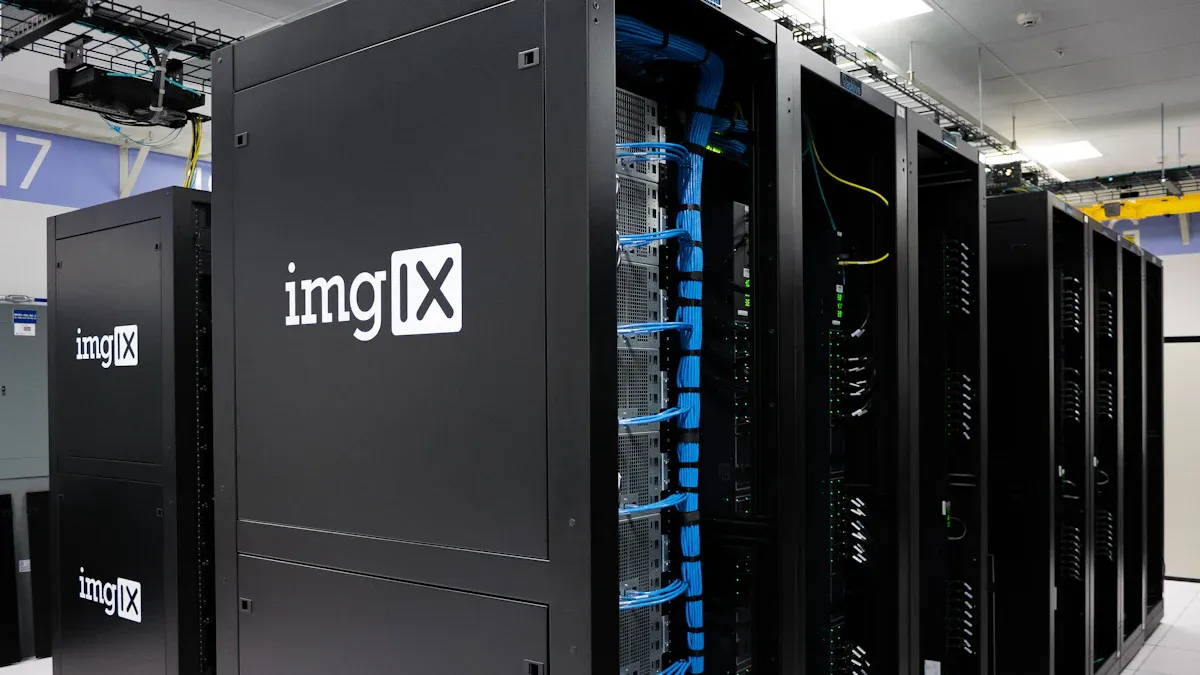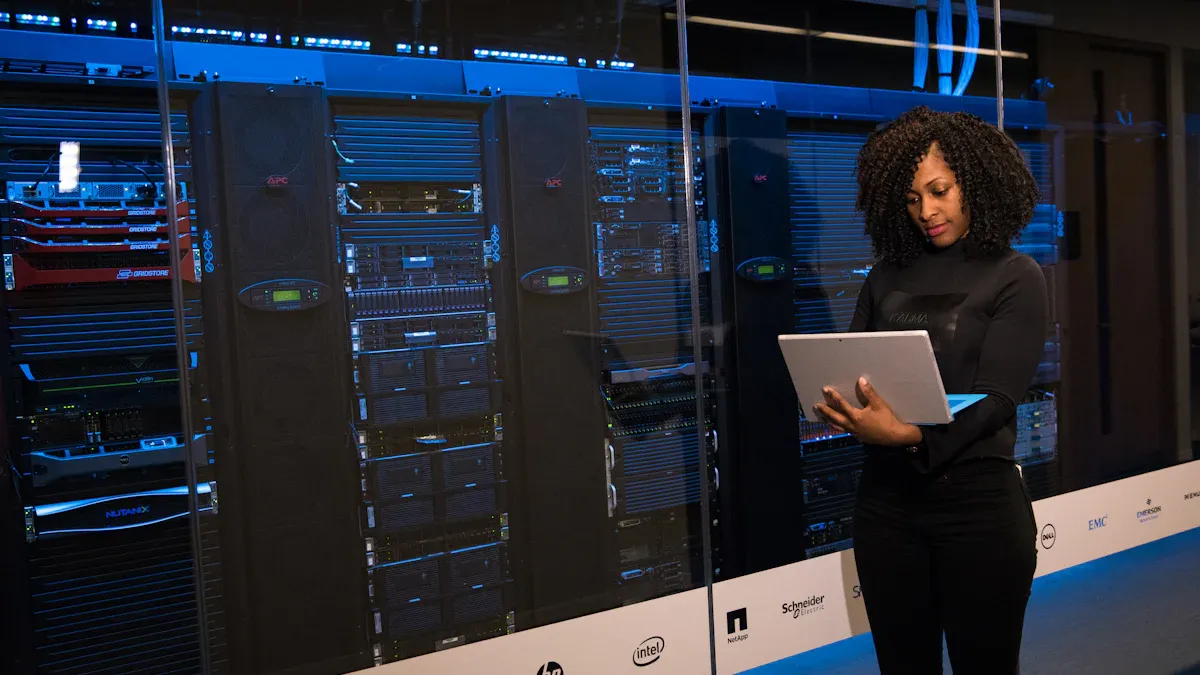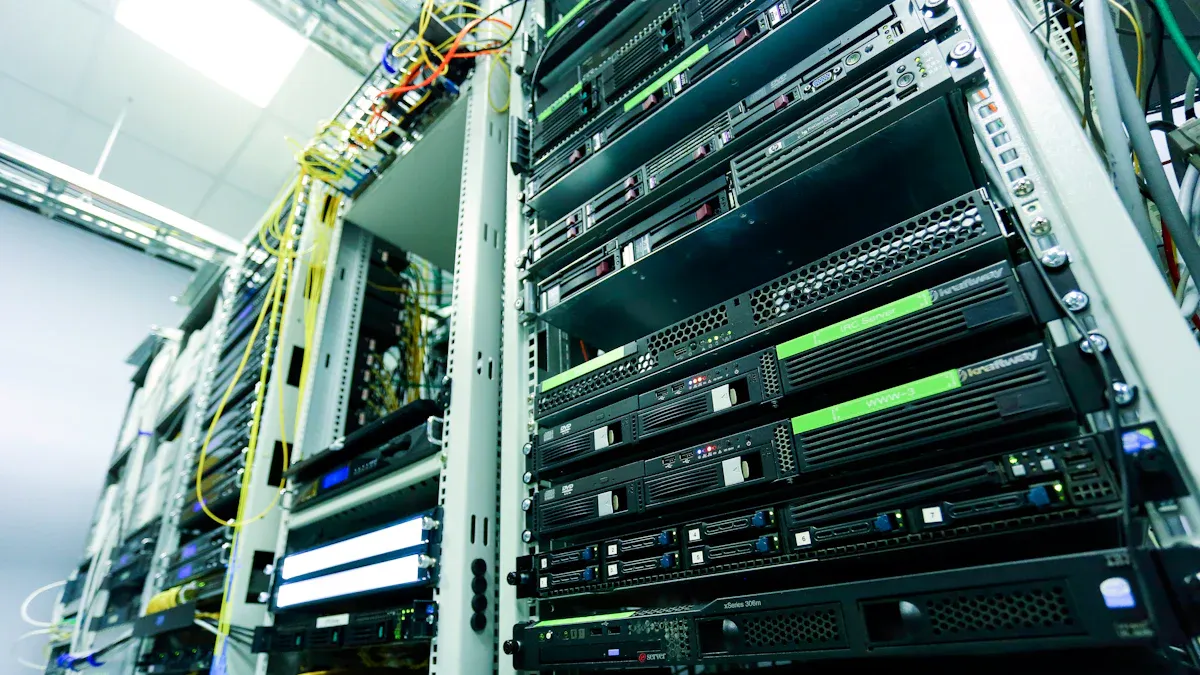
Every data center relies on a Smart PDU to achieve accurate power monitoring, remote control, and operational efficiency. Operators gain real-time visibility at the device level, minimize downtime with proactive alerts, and optimize power distribution for high-density workloads.
- Real-time monitoring and control
- Power cycling for connected devices
- Enhanced transparency through per-outlet measurement
Key Takeaways
- Smart PDUs provide real-time power monitoring and remote control, helping data centers detect issues early and reduce downtime.
- Using Smart PDUs lowers energy costs and improves efficiency by optimizing power use and supporting predictive maintenance.
- Smart PDUs offer flexible, scalable solutions that grow with data center needs while supporting sustainability and operational reliability.
Understanding Smart PDU

What Is a Smart PDU?
A Smart PDU is an advanced power distribution unit designed for modern data centers. It provides real-time monitoring, remote management, and environmental sensing at the rack or outlet level. Operators can track power consumption, voltage, current, temperature, and humidity. These features enable proactive management and rapid response to potential issues. Smart PDUs often include automation, predictive analytics, and self-healing capabilities, which help prevent downtime and optimize energy use.
Smart PDUs support modular designs, allowing seamless expansion as data center needs grow. They also comply with strict industry standards, ensuring reliability and future-proofing.
Smart PDU vs. Basic PDU
| Metric | Basic PDUs | Smart PDUs | Improvement/Benefit |
|---|---|---|---|
| Monitoring | None | Real-time, outlet-level monitoring of power and environment | Enables precise and continuous monitoring |
| Control | Manual, physical on/off switch | Remote management, scheduling, overload alerts | Reduces downtime and disruptions |
| Downtime Incidents | Not tracked | 30% decrease after Smart PDU implementation | Enhanced reliability |
| Annual Energy Expenses | Not tracked | $50,000 reduction in annual energy costs | Significant cost savings |
| Environmental Sensors | Not included | Included (temperature, humidity, airflow) | Prevents equipment damage |
| Integration | None | Integration with DCIM and network tools | Centralized control |
Smart PDUs deliver advanced monitoring and control, which basic PDUs cannot match. This difference leads to improved reliability, energy savings, and operational efficiency.
Limitations of Traditional PDUs
Traditional PDUs lack the intelligence and flexibility required for today’s data centers. They do not offer real-time monitoring or remote access, limiting power management capabilities. Operators cannot identify inefficiencies or respond quickly to faults. These units also occupy more rack space, obstruct airflow, and increase cooling costs. Traditional PDUs struggle with compliance and scalability, making it difficult to meet evolving regulatory standards and power demands.
- Intelligent PDUs can reduce power waste by up to 30%, while traditional PDUs cannot achieve this.
- Remote management in advanced PDUs improves maintenance response times by 40%.
- Downtime costs for critical systems can reach $5,600 per minute, highlighting the financial risks of outdated power management.
Key Benefits of Smart PDU in Data Centers

Enhanced Power Monitoring and Control
Smart PDUs transform power management in data centers by providing real-time, granular visibility into energy consumption. Operators can monitor voltage, current, and power usage at the outlet level, which allows for early detection of anomalies and more precise control over connected devices. Modern Smart PDUs often incorporate IoT and AI technologies, enabling predictive analytics and automation. For example, AI-driven systems can achieve a Coefficient of Determination (R²) of 0.99 and a Mean Absolute Percentage Error (MAPE) of 0.02, demonstrating highly accurate energy optimization and reduced downtime.
Leading products such as Eaton’s Rack PDU G4, Delta’s SMART PDU I-Type, and ABB’s TruFit PDU offer advanced features like programmable breakers, automated thermal monitoring, and harmonic distortion measurement. These innovations support proactive management and enhance both reliability and efficiency.
- Real-time monitoring enables early anomaly detection.
- Remote management reduces the need for on-site intervention.
- Outlet-level control supports precise power cycling and scheduling.
Metered Power Distribution Units (MPDUs), a subset of Smart PDUs, have become essential for data centers seeking to optimize energy usage and minimize operational risks. Their ability to provide actionable data supports predictive maintenance and helps prevent costly downtime.
Improved Uptime and Reliability
Smart PDUs play a critical role in maintaining uptime and ensuring reliable operations. They deliver real-time alerts for power issues, allowing operators to respond before failures occur. Switched PDUs enable remote outlet control, which streamlines troubleshooting and reduces manual intervention. Universal PDUs support flexible equipment upgrades, minimizing downtime during infrastructure changes.
- Real-time alerts notify operators of power anomalies.
- Remote outlet control improves workflow efficiency.
- Accurate energy metering prevents overloads and supports capacity planning.
Smart PDUs also provide granular power quality data, such as peak and min/max values, which help prevent harmonic distortion and reduce equipment failures. Integration with building management and DCIM systems enables proactive monitoring and rapid response to potential problems, further enhancing reliability.
Cost and Energy Savings
Data centers that implement Smart PDUs benefit from significant reductions in operational costs and energy consumption. Intelligent PDUs enable real-time monitoring and outlet-level control, allowing operators to identify and eliminate underutilized equipment. Optimized power distribution reduces energy waste and lowers both power and cooling expenses.
| Context/Integration Level | Reported Energy Cost Reduction (%) |
|---|---|
| Efficient Smart PDUs vs. Conventional PDUs | 2-3% |
| Smart PDUs integrated with DCIM systems | 20-30% |
| Operational cost reductions with intelligent PDUs | Up to 30% |
Market research shows that integrating Smart PDUs with DCIM systems can reduce operational costs by up to 30%. Improvements in Power Usage Effectiveness (PUE) from an average of 1.7 down to as low as 1.2 have also been reported, reflecting enhanced energy efficiency. Precise outlet-level metering supports accurate billing for colocation customers, reducing disputes and improving revenue transparency.
Sustainability and Environmental Impact
Smart PDUs contribute to sustainability by enabling data centers to reduce their carbon footprint. Intelligent rack PDUs provide precise measurement of power usage and available capacity at each rack, helping operators identify energy consumption patterns and eliminate waste. Switched PDUs allow remote shutdown of idle equipment, addressing the issue of ‘ghost servers’—which can account for up to 30% of servers in a typical data center.
Data Center Infrastructure Management (DCIM) software integrates with Smart PDUs to automatically calculate Power Usage Effectiveness (PUE), track carbon footprint, and identify power hogs in real time.
- Smart PDUs help identify and manage idle servers, reducing unnecessary energy use.
- Real-time monitoring supports informed energy management decisions.
- Data centers consume 1-3% of global electricity, making energy-saving technologies essential for sustainability.
By monitoring energy consumption at every power connection point, Smart PDUs empower operators to make data-driven decisions that lower energy use and support environmental goals.
Flexibility and Scalability
Modern data centers require flexible and scalable power management solutions. Smart PDUs support modular configurations, allowing operators to adapt to high-density server environments and evolving infrastructure needs. Real-world deployments, such as the Cisco PENN 1 project, demonstrate how Smart PDUs integrated with energy management platforms enable precise measurement and control at both rack and device levels.
- Real-time tracking of power usage and environmental factors provides critical insights for optimal conditions.
- Remote management capabilities allow 24/7 access to power systems from any location.
- Load balancing and redundancy features support high-density and distributed environments.
- Compliance with safety standards ensures equipment protection and audit readiness.
Key operational metrics, including PUE, power quality indicators, and environmental monitoring, validate the scalability benefits of Smart PDUs. Their integration with AI and IoT technologies ensures future-proof power management, supporting both current and future data center growth.
Smart PDU investments deliver long-term value for data centers. Operators gain:
- Real-time and historical energy visibility for better cost control.
- Advanced analytics for proactive maintenance and reduced downtime.
- Unified monitoring that supports sustainability and future growth.
These features help data centers remain efficient, resilient, and competitive.
FAQ
What makes a Smart PDU different from a basic PDU?
Smart PDUs offer real-time monitoring, remote management, and environmental sensors. Basic PDUs only distribute power without advanced features or data collection.
Can Smart PDUs help reduce downtime in data centers?
Smart PDUs send alerts for power issues and allow remote control. Operators can respond quickly, which helps prevent outages and improves uptime.
Are Smart PDUs difficult to install or integrate?
Most Smart PDUs support plug-and-play installation. They integrate easily with DCIM software and network tools, making deployment straightforward for most data center teams.
Post time: Jun-27-2025





